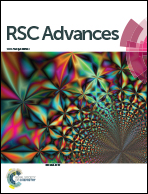Synthesis and biological evaluation of novel fluorinated anticancer agents incorporating the indolin-2-one moiety†
Abstract
A series of novel fluorinated anticancer agents containing the indolin-2-one moiety were designed, synthesized and evaluated for their anticancer activities in vitro. Among them, compounds 6, 7, 9, 12 and 13 showed potent activities against the tested human cancer cell lines. Notably, compound 6 showed significant activities against A549, Bel7402, HepG2, HCT116 and HeLa cancer cell lines, which were comparable to those of sunitinib. Further study on its mechanisms demonstrated that compound 6 can be used as a potential anticancer agent for inhibiting proliferation and inducing apoptosis of HepG2 cells, along with inhibiting angiogenesis of HUVECs.


 Please wait while we load your content...
Please wait while we load your content...